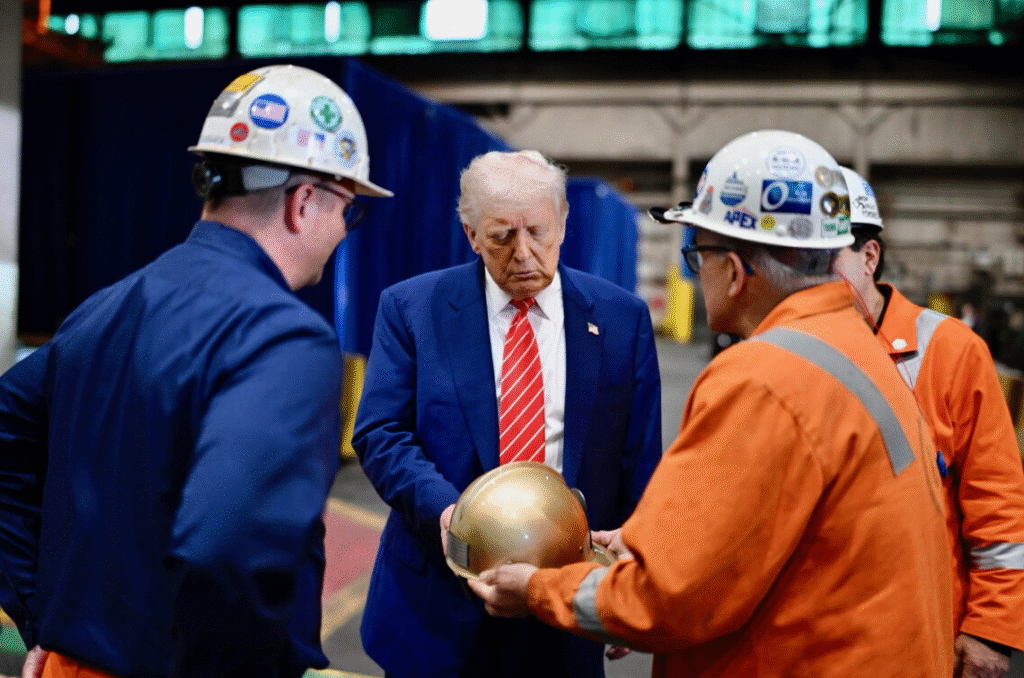President Trump Announces Steel and Aluminum Tariffs: On May 30, 2025, President Donald Trump delivered a high-profile speech in West Mifflin, Pennsylvania, announcing a major escalation in U.S. trade policy. The president declared that tariffs on imported steel and aluminum, which were previously set at 25%, will be increased to 50% starting June 4, 2025. The announcement came alongside news of a new agreement between U.S. Steel and Nippon Steel, a significant development in the ongoing efforts to protect and revitalize American steel manufacturing.
President Trump Announces Steel and Aluminum Tariffs to 50%
On May 30, 2025, President Donald Trump delivered a high-profile speech in West Mifflin, Pennsylvania, announcing a major escalation in U.S. trade policy. The president declared that tariffs on imported steel and aluminum, which were previously set at 25%, will be increased to 50% starting June 4, 2025. The announcement came alongside news of a new agreement between U.S. Steel and Nippon Steel, a significant development in the ongoing efforts to protect and revitalize American steel manufacturing.
During his address, President Trump emphasized the importance of using American-made steel in national projects, saying, “We don’t want America’s future to be built with shoddy steel from Shanghai. We want it built with the strength and the pride of Pittsburgh.” His remarks highlighted a continued focus on domestic industry and national security concerns surrounding foreign steel imports.

Analysts at CNN said that the doubling of tariffs was an unexpected and dramatic step. While some speculation had existed about tariff adjustments, the increase to 50% surprised many experts and raised immediate concerns about potential economic consequences.
Treasury Secretary Scott Bassett was present with the president, underscoring the administration’s commitment to this tough trade stance. The tariff hike is a response to ongoing tensions stemming from Nippon Steel’s $15 billion planned investment in the U.S. steel sector, which has faced backlash over national security worries and economic impacts since 2023.
Despite the deal, questions remain about how control and decision-making power will be divided. White House officials, including trade advisor Peter Navarro, assured the public that Nippon Steel would not have controlling authority over final decisions, but some observers remain skeptical about how this will play out given the scale of the investment.
Former Trump economic adviser Stephen Moore expressed support for the Nippon Steel agreement but voiced concerns over the tariff increase. He referenced studies from the president’s first term, which showed that while tariffs helped save steel industry jobs, they also raised costs for downstream manufacturers such as car companies, ultimately leading to job losses in those sectors.
Moore pointed out that unlike the earlier tariff regime, this new 50% tariff comes with no exclusions, making it far more stringent. This could mean higher costs for industries relying on steel, including automobile manufacturers, potentially raising prices for consumers and risking job losses outside the steel sector.
Legal questions surrounding the president’s authority to impose tariffs without Congress continue to loom. Courts have issued mixed rulings, and the issue may eventually be settled by the Supreme Court. The administration remains confident it can maintain the tariffs through various legal mechanisms if necessary.
On the international front, Moore praised Trump’s recent negotiations with the UK and China, which secured some concessions, though he acknowledged ongoing frustrations with China’s compliance. The administration views China as a strategic adversary, citing concerns over military build-up, intellectual property theft, and trade violations.
The debate over global economic leadership between the U.S. and China remains a central theme. Moore emphasized the need for the U.S. to invest in education, workforce training, and innovation to remain competitive against China’s massive population and growing economic power.
At the Reagan Economic Forum, commentator Jimmy Diamond spoke about the “enemy within,” highlighting the importance of addressing America’s internal challenges—such as values, education, and governance—while facing global competition.
According to CNN’s Mark Stuart, although a direct call between President Trump and Chinese leader Xi Jinping has been discussed, Xi prefers diplomatic negotiations at lower levels rather than high-profile leader-to-leader talks. Should a call happen, both leaders will carefully consider the optics to maintain their political standing domestically and internationally.
The tariff increase and related trade policy moves mark a significant escalation in the Trump administration’s approach to protecting American industries. While the immediate impact may benefit steelworkers and domestic producers, the broader economic effects on related industries and trade relationships remain uncertain.
Disclaimer:
The content provided in this article is for informational purposes only and reflects analysis and commentary based on publicly available information as of May 2025. It does not constitute financial, legal, or investment advice. Readers should conduct their own research or consult with a professional advisor before making any decisions related to trade policies, investments, or business operations. The views expressed in this article do not necessarily reflect those of any affiliated organizations.

